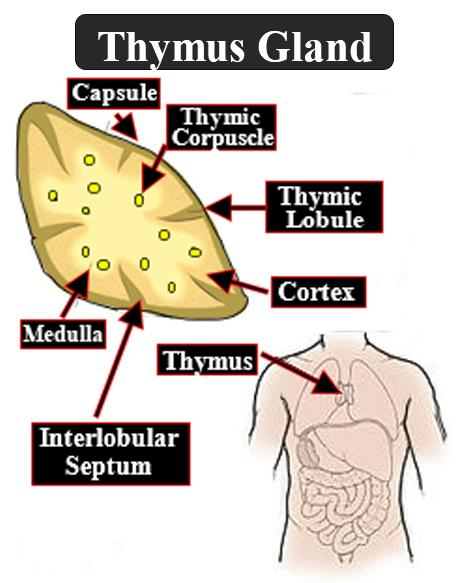
T-cells mature in the
(a)Peyer's patch
(b)Lymph node
(c)Thymus
(d)Bursa of Fabricius
Answer
561k+ views
Hint: T-cells also known as T-lymphocytes are a type of white blood cell which is an essential part of the immune system. They directly kill the infected host cell and activate other immune cells which produce cytokines and regulate the immune response. It is found within the lymphoid tissue and mucosal sites.
Complete answer:
T-cells get matured in the thymus. T cells originate in the bone marrow and mature in the thymus where they multiply and differentiate into helper regulatory or cytotoxic t cells. They become memory t cells in the thymus and are sent to the peripheral tissues which circulate in the blood or lymphatic system. Helper t cells secrete chemical messengers known as cytokinin which are stimulated by the appropriate antigen. Regulatory t cells control immune reactions and the cytotoxic t cells are activated by various cytokines that bind and kill infected cells and cancer cells. Our body can respond to any antigen virtually because of the millions of T cells that carry unique receptors.
Additional Information: Peyer’s patch: They are a grouping of lymphoid follicles in the mucous membrane which lines the small intestine. They are the small organs in the lymphatic system which are similar to lymph nodes. Peyer's patches support immune surveillance of materials within your digestive system. Immune surveillance refers to the process by which the system recognizes and destroys potential pathogens. They are located in the small intestine in the ileum area. The ileum is the last portion of the small intestine which for digest the food we eat and absorb water and nutrients from food.
Lymph node: It is a kidney-shaped organ of the lymphatic system that is linked throughout the body of lymphatic vessels. They are important for the proper functioning of the immune system and act as filters for foreign particles which include cancer cells but do not have any detoxification function. They vary in size from oval-shaped 0.1 to 2.5 cm long. The central nervous system does not contain any lymph nodes and is separated from the body by the blood-brain barrier.
Bursa of Fabricius: It is a dorsal out pocketing of the cloaca which is known as the Bursa of Fabricius which controls the antibody-mediated immunity in young birds.
So, the correct answer is 'thymus'.

Note: It was believed that fluid imbalances cause diseases in humans. Some of the symptoms of the disease are the result of the immune system doing its job. The immune system lacks a sleep cycle. An autoimmune disease where the body natural defense becomes hyperactive mostly affects women. Gut bacteria indicates a healthy immune system.
Complete answer:
T-cells get matured in the thymus. T cells originate in the bone marrow and mature in the thymus where they multiply and differentiate into helper regulatory or cytotoxic t cells. They become memory t cells in the thymus and are sent to the peripheral tissues which circulate in the blood or lymphatic system. Helper t cells secrete chemical messengers known as cytokinin which are stimulated by the appropriate antigen. Regulatory t cells control immune reactions and the cytotoxic t cells are activated by various cytokines that bind and kill infected cells and cancer cells. Our body can respond to any antigen virtually because of the millions of T cells that carry unique receptors.
Additional Information: Peyer’s patch: They are a grouping of lymphoid follicles in the mucous membrane which lines the small intestine. They are the small organs in the lymphatic system which are similar to lymph nodes. Peyer's patches support immune surveillance of materials within your digestive system. Immune surveillance refers to the process by which the system recognizes and destroys potential pathogens. They are located in the small intestine in the ileum area. The ileum is the last portion of the small intestine which for digest the food we eat and absorb water and nutrients from food.
Lymph node: It is a kidney-shaped organ of the lymphatic system that is linked throughout the body of lymphatic vessels. They are important for the proper functioning of the immune system and act as filters for foreign particles which include cancer cells but do not have any detoxification function. They vary in size from oval-shaped 0.1 to 2.5 cm long. The central nervous system does not contain any lymph nodes and is separated from the body by the blood-brain barrier.
Bursa of Fabricius: It is a dorsal out pocketing of the cloaca which is known as the Bursa of Fabricius which controls the antibody-mediated immunity in young birds.
So, the correct answer is 'thymus'.

Note: It was believed that fluid imbalances cause diseases in humans. Some of the symptoms of the disease are the result of the immune system doing its job. The immune system lacks a sleep cycle. An autoimmune disease where the body natural defense becomes hyperactive mostly affects women. Gut bacteria indicates a healthy immune system.
Recently Updated Pages
Why are manures considered better than fertilizers class 11 biology CBSE

Find the coordinates of the midpoint of the line segment class 11 maths CBSE

Distinguish between static friction limiting friction class 11 physics CBSE

The Chairman of the constituent Assembly was A Jawaharlal class 11 social science CBSE

The first National Commission on Labour NCL submitted class 11 social science CBSE

Number of all subshell of n + l 7 is A 4 B 5 C 6 D class 11 chemistry CBSE

Trending doubts
10 examples of friction in our daily life

One Metric ton is equal to kg A 10000 B 1000 C 100 class 11 physics CBSE

Difference Between Prokaryotic Cells and Eukaryotic Cells

1 Quintal is equal to a 110 kg b 10 kg c 100kg d 1000 class 11 physics CBSE

State the laws of reflection of light

Explain zero factorial class 11 maths CBSE




